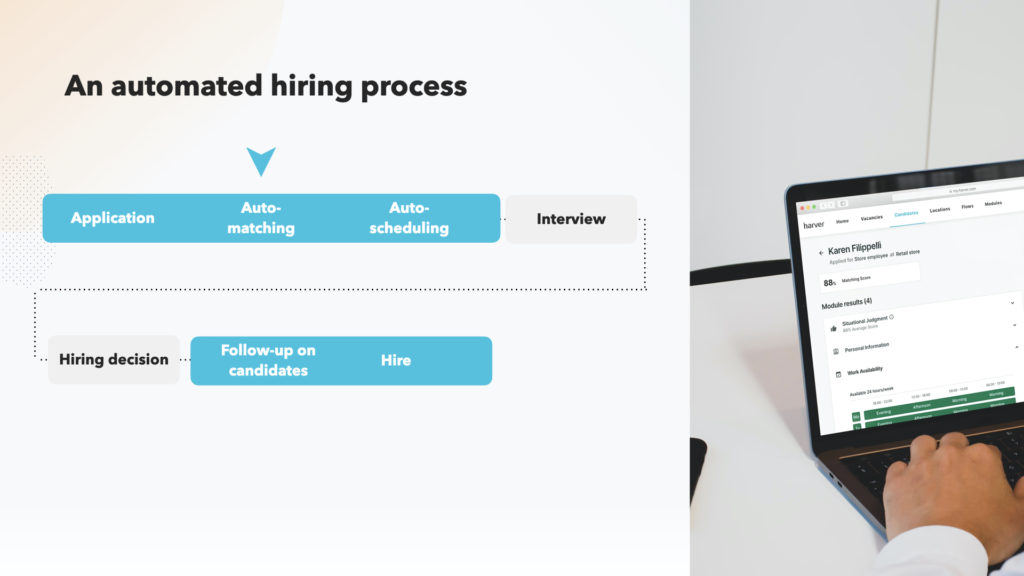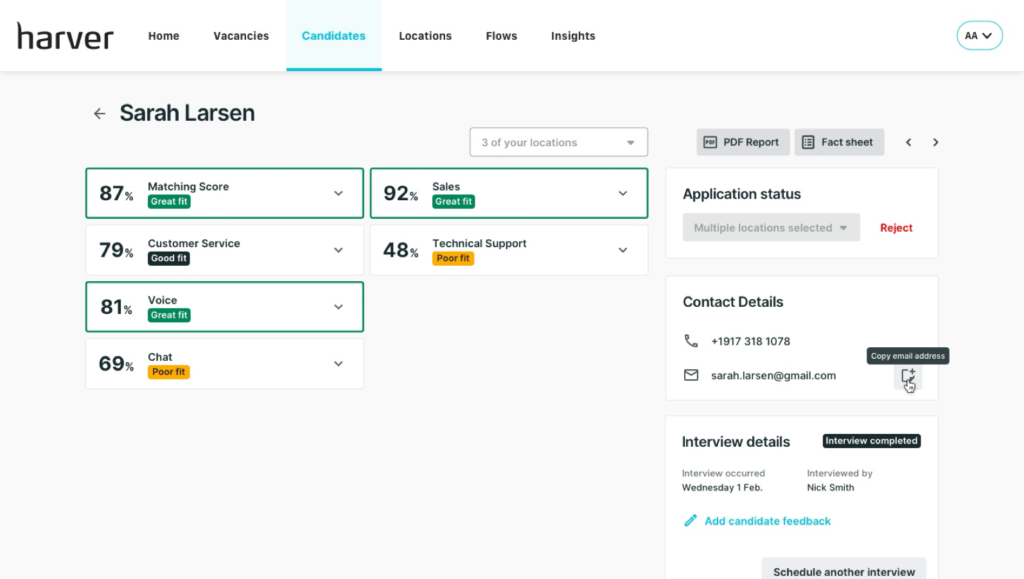While recruiters routinely track the time to fill a job vacancy for measuring how effective their recruitment process is, candidates care much more about a different metric: time to commitment.
We define time to commitment as the time between the application date and the date of giving the applicant job security.
The time to commitment is especially important in a tight labor market, for both candidates and recruiters. Candidates applying for low-complexity, entry-level positions care most about the paycheck and job security and therefore want to receive a quick job offer.
For recruiters, issuing a job offer quickly reduces the risk that candidates will continue applying to other companies because they have job security with you. Reducing your time to commitment can, therefore, help you secure talent, faster.
Let’s delve first into both these recruitment metrics in more detail, before exploring ways you can reduce each one.
What’s in?
Like what you see?
Don’t miss out. Subscribe to our quarterly digest to get the latest TA and TM resources delivered right to your inbox.
Time to fill
Time to fill metric measures the amount of time it takes you to fill an open position. Tracking this metric enables you to plan your hiring strategy more effectively and efficiently, because it highlights which stages of your hiring process are taking too long.
The time to fill is easy to measure because it represents the number of calendar days it takes you to fill an open position in your company. You need to first define what the start point is. I.e.:
- When you submit a job opening for approval
- When a job opening is approved
- When you advertise your job opening
The endpoint of your time to fill is when a candidate accepts your job offer. Choose which start point is most pertinent to your organization and make sure you use it consistently every time you track time to fill for all open positions.
Two points to note here:
- You can work out your company’s average time to fill by adding together all of your time to fill measurements for every position you’ve filled in a certain time period, and then divide that number by the number of roles you were hiring for. For example, if you hired for 3 roles, and it took you 15 days to fill the first one, 20 days to fill the second and 30 days to fill the next, you add together 15+20+30=65 days; then you divide your total time to fill i.e. 65 days / by number of roles filled, making your average time to fill: 65/3=22 days.
- If you are always hiring for certain positions, don’t include these permanently open positions in your time to fill calculations because they will inflate your average time to fill metric, without reflecting your true efficiency.
Your time to fill metric highlights how efficient your recruitment process is. Given the Society of Human Resource Management (SHRM) reports an average time to fill of 42 days, you can use this as a benchmark for how effective your recruitment process is.
Bear in mind, however, not every company will measure time to fill the same as you. Instead, rather than comparing your recruitment efforts to theirs, track the metric internally and keep track of it over the course of a year, to see whether you’re reducing your time to fill or not.
And learn 15 ways to reduce your Time to Hire!
Learn the tactics top recruitment teams in your industry leverage to reduce Time to Hire. Stop losing candidates to competitors, improve your company’s bottom line revenue and candidate experience.
Time to commitment
Time to commitment is the time between the date a candidate applies for your open roles, and the date you offer the job to the candidate.
You might not think this metric is relevant to your recruiting efficiency, but actually, when you’re recruiting to fill entry-level roles in a BPO or contact center, or staff for your QSR or retail business, in this tight labor market, it’s definitely one you want to take note of.
Tracking time to commitment can highlight where the sticking points in your application process are and can help you secure talent, faster. Why do you need to secure talent quickly?
Firstly, the type of people who ordinarily apply for low-complexity positions aren’t concerned about a career path, they’re only interested in two things: their paycheck and job security. They don’t have loyalty to any one organization, they’ll take the first job offer they get.
Therefore, the quicker you can get them through your application process and committing to taking your role, the less likely they are to apply to other companies or accept another job offer.
Secondly, in the tight labor market happening at the moment, the type of people who, pre-COVID, would have applied for your entry-level positions aren’t applying anymore. They’ve either changed industries to find work, or they might be taking advantage of the COVID-related unemployment benefits schemes.
Either way, you’re short on applicants and you can’t risk losing the ones you do have to the competition, because they offered the candidate employment faster than you did.
Time to commitment is measured by taking a note of the number of days it takes from receiving an applicant’s application to offering them the job. You can measure your average time to commitment the same way you measure time to fill.
The shorter the time to commitment, the more efficient your recruitment process. And if you find applicants rejecting your job offer consistently, it might be because your time to commitment is too high.
How to reduce time to fill & time to commitment
If you find your time to fill metric is consistently high – or consistently higher than you would like it to be, or if you find it creeping up over time, there are a few steps you can take to reduce it.
Use your ATS more effectively
You don’t have to source candidates from scratch every time you need to fill a position, you could have many qualified candidates in your candidate pool already.
Actively source even when you’re not hiring
Reach out to passive candidates even when they’re not actively job-hunting, or you don’t have a job opening for them right now. Create a connection and lay the groundwork for the future.
Use a referral program
Referrals routinely make the best employees, so leverage your referral program if you have one, or create one if you don’t. Offer incentives to existing employees for referring candidates to your open roles. Include your referral program as part of your onboarding process and ask every new employee to refer at least two potential qualified candidates.
Automate the selection process
Reduce time to commitment by eliminating all manual inefficiencies from your recruitment process. If you still have recruiters manually sourcing applicants, sifting resumes, assessing candidates, or constantly engaging with applicants before the final interview, you’re wasting their time and yours.
Not to mention you risk losing talent to the competition because of the elongated selection process. By automating the selection process you can reduce the length of your recruitment process from several weeks to just 24-72 hours.

Use talent matching software
Use talent matching software to identify candidates that are a great fit for your current positions, based on a predefined skill set and on their cultural fit. By building a custom talent-matching framework that fits your company’s needs, you increase your chances of attracting the right talent, and this helps reduce your attrition rates in the long run.

We’ve detailed the talent matching framework used by Harver in the article below.
Offer interview self-scheduling options
Don’t make successful candidates wait to hear back from your recruiters before they can schedule an interview. When you’ve found top talent, secure an interview with them now, rather than going back and forth on email.
Offer candidates a selection of interview times and dates that suit your interviewers and let candidates self schedule the option that works best for them. Once they’re committed to an interview date and time, they’re more likely to stick with you because job security is within their grasp.
Centralize recruitment data
If you recruit for multiple locations, consider using a hybrid recruitment structure that allows individual hiring managers to make the hiring decisions, but centralizes the recruitment data so that every TA team in your organization has access to the same candidates and can react fast, to offer job security within a reasonable period of time.
We’ve detailed the topic in the article below.
Next steps
If you want to reduce time to commitment, you need a fast and efficient recruitment process that allows you to make data-driven hiring decisions in a timely manner.
While the recruitment process has multiple stages, employing multiple software solutions and essentially siloing the different stages of your recruitment process means information can get lost and candidates might fall through the gaps.
For this reason, we recommend using a recruitment platform that’s built for end-to-end digital hiring, such as Harver. By using a mix of automation with talent matching technology, Harver can help you streamline and automate your entire recruitment process from start to finish.
Ready to transform your hiring process?



